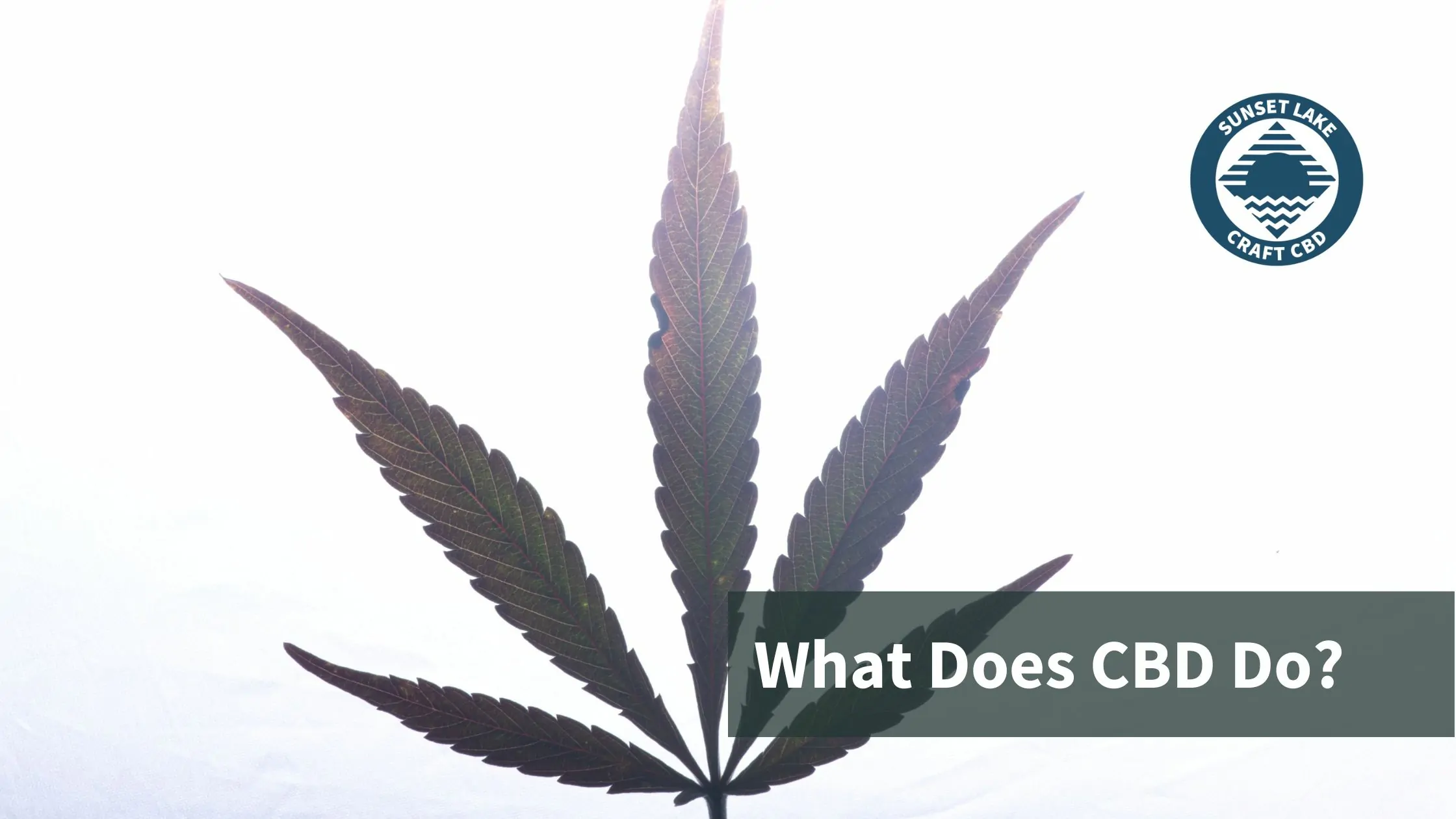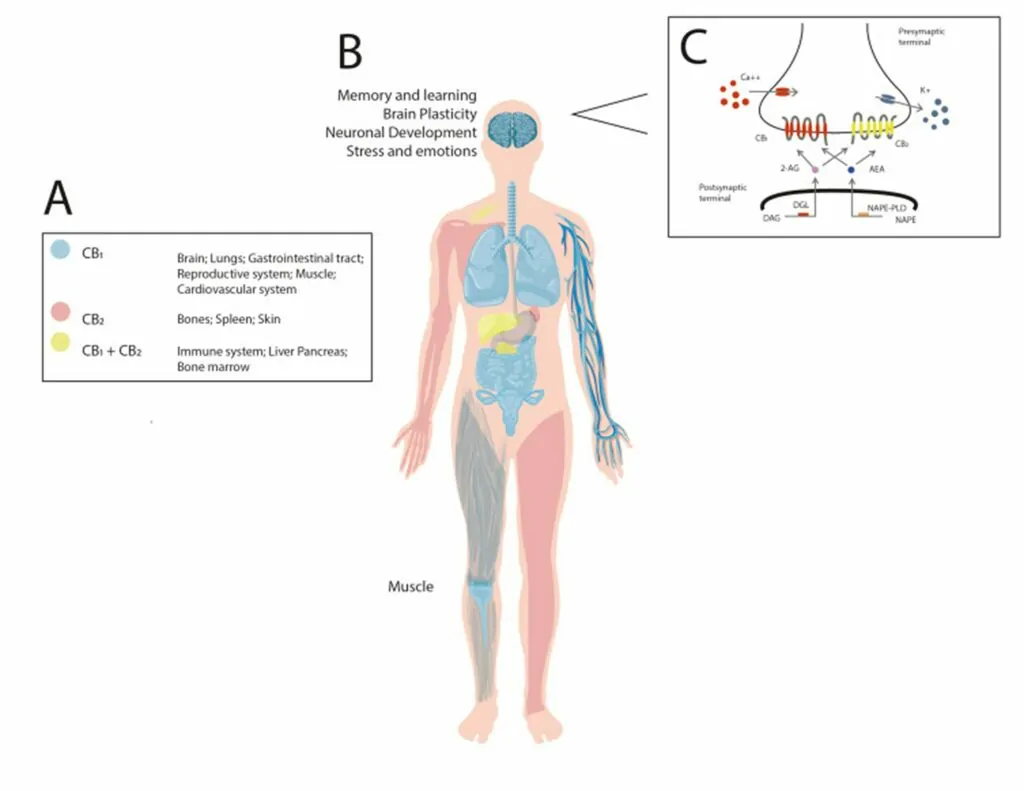No products in the cart.
What Does CBD Do? To Our Bodies, ECS, And Other Cannabinoids

Key Takeaways
- CBD helps our body and our endocannabinoid system run more efficiently.
- CBD also interacts with several other receptors around the body and brain with varying results.
- CBD, when combined with THC, can curb unwanted psychoactive effects and be more impactful in the body.
Table of Contents
- What is CBD?
- What Does CBD Do?
- CBD and the Endocannabinoid System
- CBD and Other Bodily Functions
- CBD and Other Cannabinoids
As cannabinoid studies and academia become more socially acceptable, we, as consumers, are starting to get a more complete picture of what CBD does and how it interacts with the different parts of your body.
In this post, we’ll look at how cannabidiol (CBD) interacts with our endocannabinoid system (ECS), how CBD interacts with other parts of the body, and what CBD does to other cannabinoids.
But first, we have to put a disclaimer here so the FDA doesn’t ding us:
Disclaimer: The following piece should not be considered advice, medical or otherwise. This piece is purely informational and the statements within are not confirmed by any FDA-approved research.
What Is CBD?
CBD (short for cannabidiol) is one of the 100+ known cannabinoids produced by the Cannabis Sativa L. plant. While there are traces of CBD present in recreational “marijuana” plants, it is more common in hemp plants.
CBD is a non-psychoactive cannabinoid, meaning that consuming it won’t get you “high.” The World Health Organization (WHO) has stated that “In humans, CBD exhibits no effects indicative of any abuse or dependence potential…”
CBD won’t get you “high,” and it won’t cause dependence, so what does CBD do?
What Does CBD Do?
While we’re still many peer-reviewed studies away from understanding how CBD interacts with your body, we know that unlike its psychoactive counterpart, THC, CBD doesn’t bind well with your endocannabinoid system’s CB1 and CB2 receptors.
Instead, researchers believe CBD influences the CB1 and CB2 receptors in other ways, such as increasing the uptake of beneficial molecules and inhibiting the uptake of other less desirable molecules. Essentially, we believe that CBD acts as a facilitator that helps your entire endocannabinoid system run more efficiently.
Why is that important? We’ll tell you.
The Endocannabinoid System
The endocannabinoid system is an intricate cell-signaling system made up of three components:
- Endocannabinoids – Endocannabinoids are naturally occurring compounds in the body that bind to and activate cannabinoid receptors (CB1 and CB2) in the endocannabinoid system. They play a crucial role in maintaining homeostasis by regulating various physiological processes. The two main endocannabinoids are:
- Anandamide (AEA): Often referred to as the “bliss molecule,” anandamide is involved in regulating mood, memory, appetite, pain, and sleep. It has a similar structure to THC (tetrahydrocannabinol), the psychoactive compound in cannabis, and primarily binds to CB1 receptors in the brain and central nervous system. Believe it or not, you can also find anandamide in chocolate!
- 2-Arachidonoylglycerol (2-AG): This endocannabinoid is more abundant in the body than anandamide and binds to both CB1 and CB2 receptors. It plays a role in regulating immune function, inflammation, and various other physiological processes.
- Receptors – CB1 and CB2 receptors are part of the endocannabinoid system, which helps regulate various physiological processes.
- CB1 Receptors: Primarily found in the central nervous system (brain and spinal cord) and in some peripheral tissues. They play a key role in modulating neurotransmitter release, which affects pain perception, mood, appetite, memory, and coordination. Activation of CB1 receptors can influence things like pain relief, euphoria, and changes in sensory perception.
- CB2 Receptors: Mainly located in the peripheral nervous system and immune cells. They are involved in modulating immune responses and inflammation. Activation of CB2 receptors can help reduce inflammation and pain, making them a target for managing conditions like arthritis and other inflammatory disorders.
- Enzymes – ECS enzymes are responsible for the synthesis and degradation of endocannabinoids. These enzymes ensure that endocannabinoids are produced as needed and broken down after they have performed their functions. This regulation is essential for the proper functioning of the endocannabinoid system in processes such as pain sensation, mood regulation, immune response, and more.

What Is The ECS Responsible For?
Now that we know what parts make up the endocannabinoid system and that CBD helps it run more efficiently let’s put that into practical terms.
CBD helping our ECS run more efficiently is great because our ECS influences so many bodily functions, including:
- Pain Sensations
- Mood Regulation
- Appetite and Digestion
- Immune and Inflammation Response
- Memory and Learning
- Motor Control
- Reproductive Health
- Cardiovascular Health
- Stress Response
- Skin Health
But CBD’s interactions with our body don’t begin and end at the endocannabinoid system. Read on to learn how CBD interacts with other parts of our brain and body.
How CBD Interacts With The Body
While CBD research is still in its infancy, a handful of bodily interactions have been observed and documented, which we will review in the sections below.
What Does CBD Do To 5-ht1A Receptors?
5-ht1A receptors are a type of serotonin receptor. They help moderate sleep, anxiety, pain, perception, appetite, nausea, vomiting, and sociability.
When taken in higher doses, CBD has been known to interact with this receptor, though not to the same extent as serotonin.
We believe that by activating these serotonin receptors, CBD may have anti-anxiety, anti-depressive, and neuroprotective effects. Only time and further research will confirm whether or not that’s true.
What Does CBD Do To Adenosine?
Adenosine is a naturally occurring compound that acts as a central nervous system depressant. Put simply, adenosine makes you sleepy.
It’s believed that CBD somewhat prevents adenosine reuptake (the same is true of caffeine and Vitamin B12) and activates our A2A receptors— a receptor that helps mitigate the body’s inflammation response.
This may explain why many CBD users report that its use, both internal and external (topical), helps reduce their inflammation and makes them more tired.
What Does CBD Do For GPR55 Antagonization?
Known sometimes as the CB3 receptor or “orphan receptor,” GPR55 receptors are G-protein coupled receptors involved in several physiological processes.
Most are located in the cerebellum near the brainstem and help manage an individual’s blood pressure and bone density. Unfortunately, when activated, GPR55 receptors have been linked to the proliferation of cancer cells.
CBD helps to ‘antagonize’ GRP55 receptors, meaning that CBD helps counteract the receptors’ normal functions. These early findings may suggest CBD’s potential in treating conditions like high blood pressure and osteoporosis. Further research is required.
CBD isn’t the only actor in all of these interactions, though. In the next section, we’ll explore the interactions between CBD and the other cannabinoids that also influence the ECS.
What Does CBD Do To Other Cannabinoids?
So far, we’ve covered just a bit of what CBD does to your endocannabinoid system and some of your other receptors, but we have yet to cover what CBD does to its fellow phytocannabinoids.
As of this writing, only one inter-cannabinoid relationship has been studied in depth, and that’s what CBD does to THC.
What Does CBD Do To THC?
Similar to the interactions with the receptors listed above, CBD can affect the CB receptor’s uptake of THC and can diminish some of the unwanted effects— namely, paranoia and “the munchies.”
While studies into what we call the “entourage effect,” the effects brought on by the use of whole-plant cannabis, are still in their infancy, the horizon of cannabinoid research is broad and exciting for sure.
What Does CBD When Combined With THC?
We’ve gotten this question before. CBD not only counteracts THC’s unwanted effects, but as we mentioned, when you use both cannabinoids (plus the others found in full-spectrum extracts), you’ll experience what we call the entourage effect.
We believe that hemp and cannabis products can produce more therapeutic effects when they are full-spectrum and can provide you with the entourage effect. This framing is very much in the holistic medicine camp and, as such, doesn’t have too much literature to back it up. However, there is plenty of anecdotal evidence to suggest that CBD works better in your body when combined with THC.
What Does CBD Do Once You’re Done With It?
We’ve covered how CBD affects your body, your ECS, and other cannabinoids, so there’s only one place left for it to go: out.
Like THC, CBD is an external cannabinoid, and so it must return to the external world. When your body is done with CBD, it’s sent to the liver. Your liver breaks down CBD into metabolites that leave your body via urine, hair, excrement, etc.
Wrapup
While we still don’t know too much about CBD and phytocannabinoids thanks to cannabis prohibition, studies are coming out day after day that explain the benefits of CBD.
As those studies come out, we’ll do our best to let you know and break them down. Be sure to subscribe to our newsletter email list and check out our lineup of farm-direct CBD products in the meantime.
Sources
- “Cannabidiol (CBD) Pre-Review Report.” Expert Committee on Drug Dependence, World Health Organization, 10 Nov. 2017
- Lu, Hui-Chen, and Ken Mackie. “An Introduction to the Endogenous Cannabinoid System.” Biological psychiatry vol. 79,7 (2016): 516-25. doi:10.1016/j.biopsych.2015.07.028
- Martínez-Aguirre C, Carmona-Cruz F, Velasco AL, Velasco F, Aguado-Carrillo G, Cuéllar-Herrera M and Rocha L (2020) Cannabidiol Acts at 5-HT1A Receptors in the Human Brain: Relevance for Treating Temporal Lobe Epilepsy. Front. Behav. Neurosci. 14:611278. doi: 10.3389/fnbeh.2020.611278
- Mecha, M et al. “Cannabidiol provides long-lasting protection against the deleterious effects of inflammation in a viral model of multiple sclerosis: a role for A2A receptors.” Neurobiology of disease vol. 59 (2013): 141-50. doi:10.1016/j.nbd.2013.06.016
- Andradas C., Caffarel M.M., Pérez-Gómez E., Guzmán M., Sánchez C. (2013) The Role of GPR55 in Cancer. In: Abood M., Sorensen R., Stella N. (eds) endoCANNABINOIDS. The Receptors, vol 24. Springer, New York, NY. https://doi.org/10.1007/978-1-4614-4669-9_5
- Partow, Cyrus. “How CBD Affects the Endocannabinoid System – Elite Learning.” Elite Learning, 27 Feb. 2019, https://www.elitecme.com/resource-center/rehabilitation-therapy/how-cbd-affects-the-endocannabinoid-system.
- Brown, A J. “Novel cannabinoid receptors.” British journal of pharmacology vol. 152,5 (2007): 567-75. doi:10.1038/sj.bjp.0707481
- Paulsen, Candice E et al. “Structure of the TRPA1 ion channel suggests regulatory mechanisms.” Nature vol. 520,7548 (2015): 511-7. doi:10.1038/nature14367
- Walsh, J.H., et al., Treating insomnia symptoms with medicinal cannabis: a randomized, crossover trial of the efficacy of a cannabinoid medicine compared with placebo. Sleep, 2021. 44(11)
